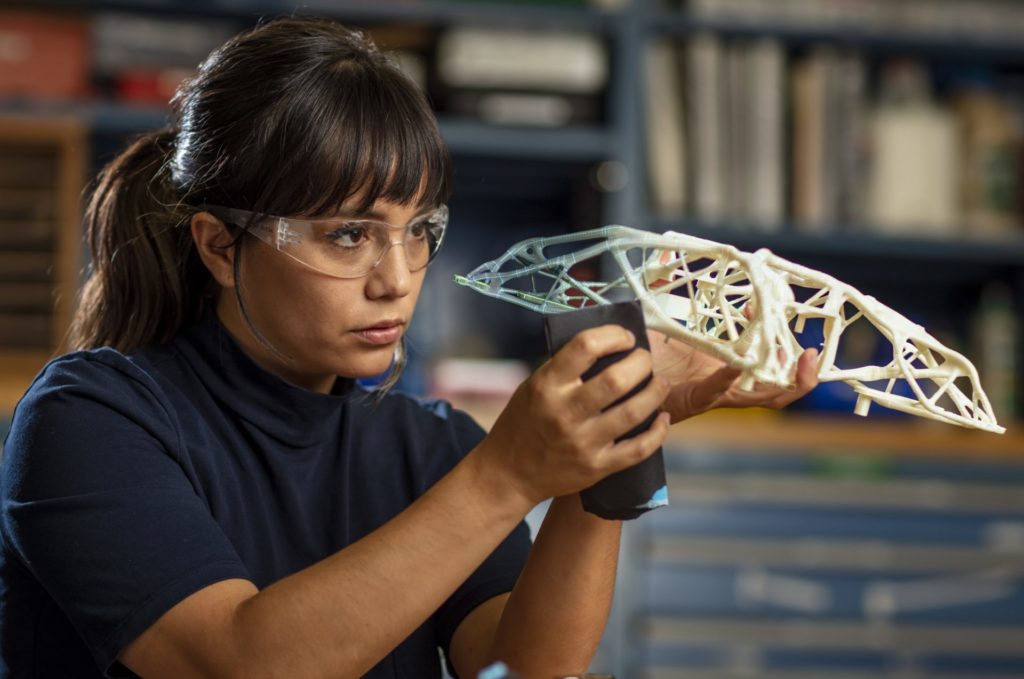& Construction

Integrated BIM tools, including Revit, AutoCAD, and Civil 3D
& Manufacturing

Professional CAD/CAM tools built on Inventor and AutoCAD
3 min read
This post is also available in: Français (French) Italiano (Italian) Deutsch (German) 日本語 (Japanese)
Generative design in Autodesk Fusion 360 is a tool powered by AI that is shaping the future of manufacturing, one unique outcome at a time.

Generative Design in Fusion 360 is upping the game for design for manufacture. It may even be a much-needed dawning of disruption for the design and manufacturing industries. But why do we need this type of disruption? The reality is, teams currently manufacture physical products using tools 20 years behind the teams who develop software applications.
Geometry creation systems are difficult to use, simulation systems are challenging to understand, and CAM systems require experts. Additionally, most of these systems are proprietary and do not easily talk to each other. Both of these challenges contribute to a manufacturing skills gap.
In addition to offering generative design capabilities, Fusion 360 is a full-fledged CAD/CAM tool. Combining all of these tools is highly compelling to designers and engineers. In this article, we’ll dive into how generative design in Fusion 360 addresses the skills gap.
Many machinists have retired, left their jobs due to the COVID-19 pandemic, or outsourced their work overseas. Their skills have not been shared with the younger generation, leaving behind a skills gap. How does generative design in Fusion 360, along with its CAM tools, help bridge this skills gap?
Generative design prepares teams for the new realities of manufacturing. Engineers no longer have to spend the bulk of their time defining a CAD model before validation can take place. With generative design, engineers spend more time describing their engineering challenges and specifying performance criteria and constraints.
Generative design in Fusion 360 provides additive and subtractive manufacturing outcomes, so teams can generate outcomes based on unique design and engineering needs. The designer or engineer defines only minimal geometry with generative design — connection points, hold-out areas, etc. — not a complete CAD model. The generative design engine (not the engineer) creates all valid CAD model topology options based on the specified constraints. This exposes a wide range of potential design options for consideration, along with manufacturing-aware trade-off studies.
A report published last year by The Manufacturing Institute and Deloitte found that 4.6 million jobs will need to be filled in the sector over the next decade, and 2.4 million jobs may be left open due to a lack of trained workers. The shortage of workers has been the top concern in the industry for the past six quarters. This shortage needs attention.
Fusion 360 with CAM and generative design may be the answer to addressing this manufacturing skills shortage. This means the development of new skill sets, new processes, and new ways of thinking will be required.
There is often fear or pushback when Fusion 360 users learn the underlying technologies of generative design are artificial intelligence and machine learning. Many think (incorrectly) that artificial intelligence and machine learning will eventually replace their skills and jobs.
Artificial intelligence is no longer science fiction – companies and individuals are using it every day – without even knowing it. Most people do not realize that artificial intelligence has been around for over 50 years. Today, artificial intelligence and machine learning are all around us and have infiltrated our daily lives without us knowing.
As I know from personal experience, artificial intelligence correctly diagnoses cancer and other serious maladies early. Artificial intelligence also protects us by detecting credit card and banking fraud before it happens. Every time you make a Google search, you are helping to build their massive artificial intelligence engine. And artificial intelligence is at work every time your TV provides suggestions on what you might like to watch.
The term “artificial intelligence” may be somewhat overblown. Today, “artificial intelligence” is more analogous to a decision support engine — not some type of sentient being that can take their jobs.
Give the Fusion 360 Generative Design Extension a try today for free to see how this powerful tool can shape your team’s workflow:

By clicking subscribe, I agree to receive the Fusion newsletter and acknowledge the Autodesk Privacy Statement.
Success!
May we collect and use your data?
Learn more about the Third Party Services we use and our Privacy Statement.May we collect and use your data to tailor your experience?
Explore the benefits of a customized experience by managing your privacy settings for this site or visit our Privacy Statement to learn more about your options.